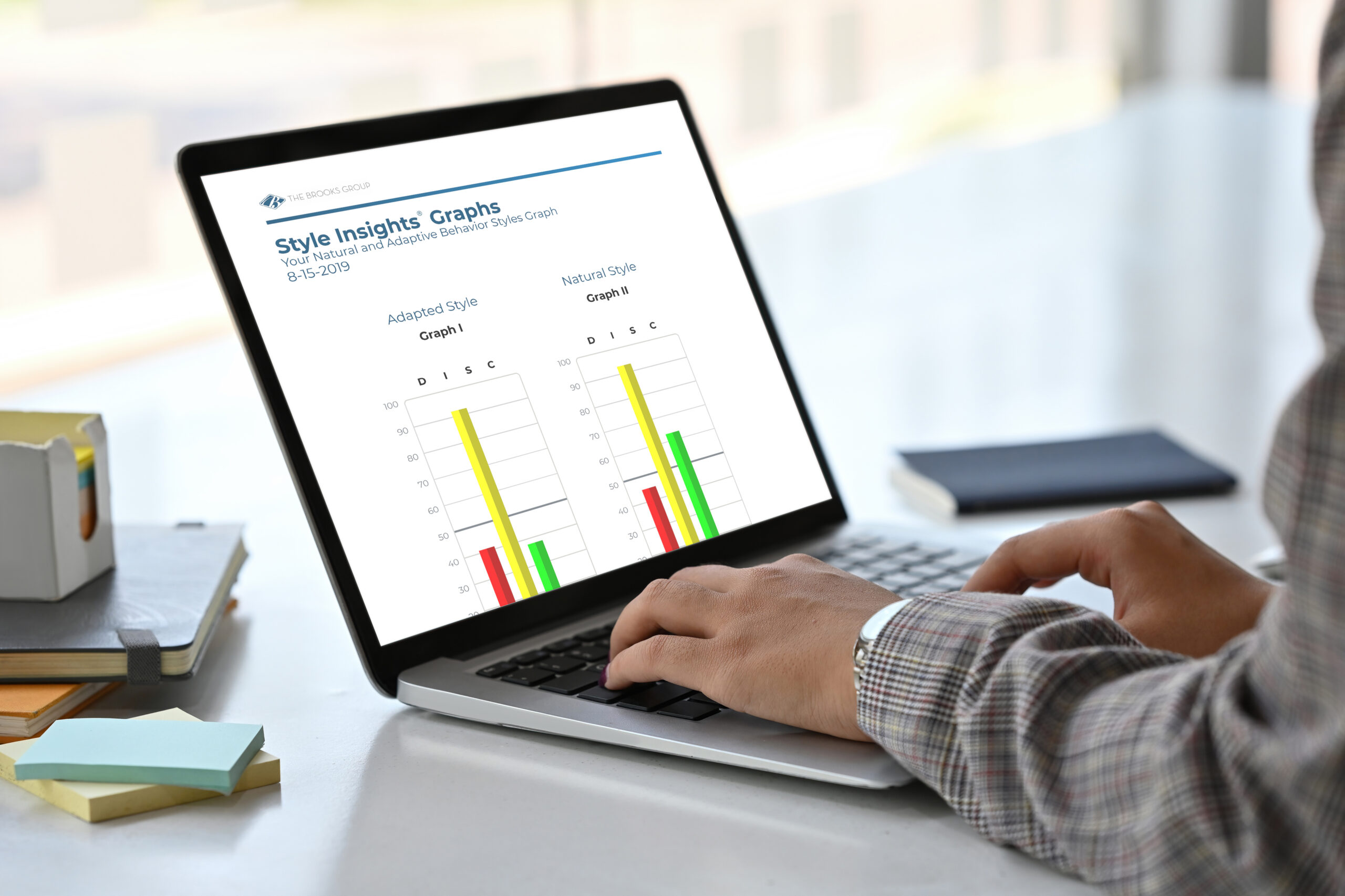Assessments have gained immense popularity as a tool for understanding individual behavioral patterns, communication styles, and decision-making processes. One personality test in particular has become the go-to for sales leaders: The Brooks Talent Index DISC assessment.
Michelle Richardson, Vice President of Sales Performance Research at The Brooks Group, is an expert on personality and skills assessments and their impact on sales team dynamics. In this interview, she describes how sales leaders can use the sales-specific DISC profile to understand individual personality types, improve sales training, and build a stronger sales team.
Expert Interview: Build a Stronger Sales Team Using DISC
TBG (The Brooks Group): How would you describe DISC and why is it important?
Michelle Richardson: DISC is simply how an individual does something. You may also hear it referred to as behavior styles or communication styles. This impacts how they communicate, how they interact with others, and for salespeople, how they sell.
There are four components to it: Dominance, Influence, Steadiness, and Compliance. You may hear people refer to being a “high I” or a “high C”. That might be a primary style. But everyone is a combination of all styles.
- D: How we respond to problems
- I: How we respond to people
- S: How we respond to pace
- C: How we respond to procedures
TBG: What are the main benefits of using the DISC assessment?
Michelle Richardson: I’m a huge fan of assessments. It’s gold for a manager to be able to unlock sales performance and DISC is one part of that.
I think self awareness is one of the most powerful tools that a salesperson or a manager can have. Understanding how to effectively communicate—whether it’s with your customer or your team member—is right up there with that.
DISC also gives a team a common language for communication. If a sales team is experiencing a challenge, DISC can help figure out the next best step. For example, if you’re considering a training initiative, or implementing some type of change, I recommend starting with an assessment. An assessment is also valuable for a new sales leader coming into an organization who wants to understand the overall makeup of their team,
Knowing individuals’ behavioral tendencies and communication preferences is incredibly important for building effective teams and for getting the most out of individuals. Treating everyone on the team with the same broad brush just doesn’t work.
It’s gold for a manager to be able to unlock sales performance and DISC is one part of that.
TBG: Why should managers incorporate DISC into sales training?
Michelle Richardson: It’s important to incorporate DISC in sales onboarding, training, and sales management training because of the power of self awareness. When you get your DISC profile, you understand where your strengths are.
It answers questions like: Where do I need to really pay attention and focus target my own development? Do I need to practice questioning skills because I might have a tendency to talk more than listen? Or do I need to get really comfortable in asking for the business?
DISC also allows sales professionals to understand their own style and recognize somebody else’s style. It can help them present information in a way that the customer is most receptive to receiving.
For example, if you’re presenting a proposal to a high D, you may want to include a brief summary with concise, results-focused bullet points. If you’re presenting to a high I, include some testimonials. If you’re presenting to a C, make sure that you have data to back up your proposal—performance data, ROI, or statistics, whatever may be appropriate to your solution.
If you’re presenting to an S, talk about how you’re going to minimize the impact of any changes your solution may have on their organization. Make sure you address that in your presentation and give reassurances in that direction.
Watch this video to learn more about presenting to different behavior styles:
TBG: How can a salesperson understand their prospect’s DISC style? They won’t come to the meeting with an “S” on their forehead.
Michelle Richardson: There are ways to identify someone’s style, whether you are interacting face-to-face or on the phone. A person’s style is reflected in their pace, tone of voice, and focus.
If someone speaks or moves with a rapid pace, they’re more likely higher on the D or the I, the Dominance or Influence. Someone who is more reserved or speaks with a steady or deliberate pace will lean more towards the S and the C.
Ds and Cs tend to be more results or task focused, so that’s where they’ll focus. Is and Ss are going to be more relationship focused. They’re going to talk about things in terms of impact on people.
Ds and Is are going to move a little bit faster. Ss and Cs are going to be a little more quiet. They’re going to move at a little bit slower pace. So those are a few clues.
There are also visual cues. Ds will lean in with direct eye contact and are going to be much more expressive. Ss and Cs are going to keep their body language more controlled.
If a salesperson is meeting a prospect for the first time and doesn’t know what their style is, I recommend they approach in neutral. This means not displaying any strong behavioral tendencies one way or the other. That gives the salesperson time to read the other person, identify their style, and then adjust their approach as needed.
Watch this video to learn more about approaching customers in neutral:
TBG: How can understanding DISC profiles help sales managers communicate?
Michelle Richardson: DISC gives a manager an understanding of how to communicate effectively with a salesperson—how to give them information in the way they want to receive it.
It also helps understand natural tendencies and identify where to coach. Coaching two salespeople with contrasting styles requires different approaches for each.
At The Brooks Group, we do individual sales hiring assessments, and DISC is a component of those. It’s helpful in identifying how someone will perform in a sales role. I also spend time working with managers to understand their team for coaching, communication, and training purposes. We plot their team’s DISC styles graphically on a wheel – it’s essentially a visual representation of their team dynamics – and consult with them to understand and address areas of complement and conflict within their team.
We can identify, for example, where two people are going to have potential for tension. These sellers have similar styles, and they’re going to get along really well. Or, this is where your outside sales rep may have a conflict with your sales engineer, because they’re wired differently. We’ll also discuss strategies to really maximize the team’s performance in each of these situations.
From a sales coaching perspective, it can be helpful to pair up people with different styles. If you’ve got a salesperson who’s great at opening new accounts or prospecting—maybe they’re high D, and not as strong with details, administration, or servicing—pair them with a S or C.
When you pair sales reps together, they can mentor and support each other. For peer coaching and advice, this support can be very helpful.
DISC gives a manager an understanding of how to communicate effectively with a salesperson.
TBG: How can DISC help a sales manager with change management?
Michelle Richardson: For sales managers, there are a lot of advantages in terms of team communication, managing change, rolling out new products, and how you approach the everyday business of selling.
For example, when rolling out new products, Ds and Is are going to embrace new offerings more quickly. A D is going to say, “Give me something new. Let me sell it.” On the other hand, Ss and Cs will say, “I need to see how this works. I need more information before I introduce this to my customers.”
It’s the same with change management. If you’re making an organizational change, it’s best to tell an S in advance, let them process the change, and come up with questions. They’ll come around once they understand why the change is needed – it just might take them a little longer to get there. The opposite is true of Ds and I’s.
DISC can also be helpful in identifying areas for sales training and the best way to set up a course. Knowing the DISC profiles of your team will help determine which kinds of activities and exercises will engage people. For instance, if you know you have a room full of high Ds and Is, you will want to incorporate a lot of activity and group interaction. With S and C, you’ll want more individual exercises.
You can also select facilitators based on the overall dynamic of the group to make sure that there’s the right level of rapport.
For a manager, there are a lot of advantages in terms of team communication, managing change, rolling out new products, and how you approach the everyday business of selling.
TBG: Is there an ideal DISC profile for a salesperson?
Michelle Richardson: No, there’s no universal, perfect style. Anybody can be successful in sales. However, understanding DISC styles may help an organization or a manager best align sales territories with how sellers are more naturally inclined.
For example, if you are opening a new territory and you need a salesperson to go in and do a lot of prospecting for new accounts, maybe cold calling or forming new relationships, certain behavior styles are going to be more naturally wired to favor that type of work.
If you’ve got a well-established territory with high market share, and the strategy is to maintain and maybe grow business within existing accounts, there are styles that may be more inclined to prefer account management or development activities.
There’s no universal, perfect style. Anybody can be successful in sales.
TBG: What type of personalities work well together—or don’t?
Michelle Richardson: Generally, behavior styles that are opposites of each other have the greatest potential for conflict. And it’s not that one is bad, one is good; it’s that their styles are different. And so how each style perceives the other comes into play.
Ds and Cs are more results and task focused. Is and Ss are more people focused. Ds and Is are higher energy. Cs and Ss are more reserved energy. Ds and Cs are more formal in their communication style and Is and Ss are a bit more relaxed in their communication style.
For example, a high I might have a tendency to brush over details. A high C wants all of the precise details. And so there’s the potential for a disconnect.
Or another example, a “high D” is someone who has a tendency to be very direct, very assertive. Ds can also be more fast paced, and may come across as forceful or strong.
An S is the opposite of that. An S is someone who’s steady. They’re a little more reserved. They move at a deliberate pace. A D might be perceived as coming on too strong, too direct, or too forceful to an S. The D might think the S is moving too slow.
It’s not that one is bad, one is good; it’s that styles are different. And so how we perceive the other style comes into play.
TBG: Is there an advantage to a sales team having balance across all of the styles because they can complement each other? Or does that lead to more conflict?
Michelle Richardson: It is in an organization’s best interest to have a representation of all DISC styles, because each style brings unique strengths. Ds tend to be more “big-picture” and action oriented, and Is can bring people together around an idea or vision. Ss and Cs are what I call the ‘gap finders’. They’re going to point out all the holes in a given plan or project and identify tactical implementation steps that other styles might miss.
On a cross-functional team, including different behavior styles can be very beneficial. You get a more well-rounded approach to a project, and you’re going to be much more successful as a result.
TBG: Are there specific sales skills that are naturally harder or easier for each type?
Michelle Richardson: It’s not that these skills are harder or easier. Anybody can learn sales skills. It’s more of a natural gravitation toward, comfort with, or preference for certain sales activities. When a is self aware, they can counteract, complement, or lean into whichever their natural tendencies.
To coach effectively, it’s important for a manager to know the styles of the people on their team. Sales managers should ask themselves, “What am I asking of my salespeople? Am I asking individuals to do something that’s outside of their natural comfort zone? How do I coach each person most effectively? What do I need to do to get team members where they need to be?
For instance, your Ds tend to prefer new activities. They’re looking for the new business opportunities. A high I prefers establishing new relationships. In a networking situation, they’ll walk into a room and gravitate toward the people they don’t know to start a conversation.
On the other hand, the S style prefers existing relationships. In that same networking situation, the Ss will walk into the room and think, “Who do I already know here that I can talk to first?”
This is also where things like prospecting come into play. A D may have more of a natural tendency for new business development, with the preference for new activities and driving results. They want to close new accounts. They may not be as happy servicing the same set of existing accounts on a regular basis.
Sellers with an S or a C style often prefer to prospect within their existing account base.
However, creating and following a structured, consistent process can help them become more comfortable prospecting beyond their existing network.
When a rep is self aware, they can counteract, complement, or lean into their natural tendencies.
TBG: If an organization has not used DISC, how would you introduce it?
Michelle Richardson: A lot of teams have now heard of DISC and are familiar with it. We’ve found that people love getting this information, especially when we introduce the assessment as part of sales training. They’re learning about themselves—it’s everyone’s favorite topic.
We always introduce an assessment with the messaging that it is a constructive tool. It is about making individuals more effective and improving the overall communication and effectiveness of the team. We also debrief it in our training programs so that people have context in reading and interpreting their results. We make it fun and engaging, and it’s one of the most valuable takeaways from the training experience.
Learn More
Leverage 45+ years of The Brooks Group assessment experience to ensure you have the right talent on your sales team.




